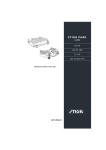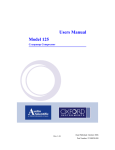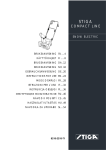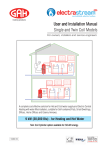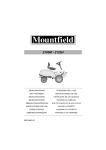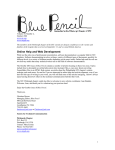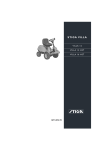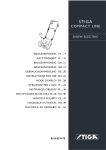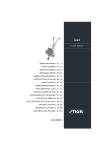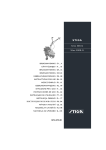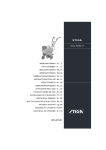Download Stiga COMPACT LINE SNOW REX User's Manual
Transcript
STIGA COMPACT LINE SNOW REX SNOW BREEZE BRUKSANVISNING SV .... 6 KÄYTTÖOHJEET FI ...11 BRUGSANVISNING DA ..17 BRUKSANVISNING NO .22 GEBRAUCHSANWEISUNG DE ...28 INSTRUCTIONS FOR USE EN...34 MODE D’EMPLOI FR....39 ISTRUZIONI PER L´USO IT.....46 INSTRUKCJA OBS£UGI PL ....52 »HC“P”K÷»fl œOÀ‹«Œ¬¿“EÀfl RU...58 NÁVOD K POU®ITÍ CS ...65 HASZNÁLATI UTASÍTÁS HU ..71 NAVODILA ZA UPORABO SL ....77 8218-2219-70 2 1 A T E B A U 3 I L H 4 BREEZE M H L E U 5 6 BREEZE R O H Q 2 N BREEZE V 8 7 REX H M L E 9 REX 10 REX O R N 11 12 3 EN ENGLISH 1 SYMBOLS The following symbols appear on the machine. They are there to remind you of the care and attention required in use. This is what the symbols mean: Warning. • • Read and understand the owner’s manual before using this machine. Danger - rotating auger. Danger - rotating fan. Keep hands out of discharge chute. Keep hands and feet away from rotating parts. Keep bystanders at a safe distance from the machine. Never point the discharge chute towards bystanders. Remove the key, disconnect the spark plug wire, and consult technical literature before performing repairs or maintenance. Risk of burns. Use hearing protection. 2 SAFETY INSTRUCTIONS 2.1 GENERAL • Please read through these instructions carefully. Learn all the controls and the correct use of the machine. • Never allow children or anyone who is not familiar with these instructions to use the snow thrower. Local regulations may impose restrictions as regards the age of the driver. • Never use the machine if others, particularly children or animals, are in the vicinity. • Remember that the driver is responsible for accidents that happen to other people or their property. • Be careful not to trip or fall, especially when reversing the machine. • Never use the snow thrower under the influence of alcohol or medication and if you are tired or ill. 2.2 PREPARATIONS • Check the area to be cleared and remove any loose or foreign objects. • Disengage all controls before starting the engine. • Never use the snow thrower unless properly dressed. Wear footwear that improves your grip on a slippery surface. • Warning – Petrol is highly inflammable. a. Always store petrol in containers that are made especially for this purpose. b. Only fill or top up with petrol outdoors, and never smoke when filling or topping up. 34 • • c. Fill with petrol before starting the engine. Never remove the filler cap or fill with petrol while the engine is running or still warm. d. Screw the filler cap on tightly and wipe up any spilt petrol. Adjust the height of the auger housing to ensure it stays above gravel paths. Never, under any circumstances, make adjustments while the engine is running (unless otherwise specified in the instructions). Allow the snow thrower to adjust to the outdoor temperature before using it. Always use protective goggles or a visor during use, maintenance and service. 2.3 OPERATION • Keep hands and feet away from rotating parts. Always avoid the discharge chute opening. • Be careful when driving on or crossing gravel paths, pavements and roads. Be aware of hidden dangers and traffic. • Never direct the discharge chute towards a public road or traffic. • If the snow thrower hits a foreign object, stop the engine, disconnect the spark plug cable and carefully inspect the machine for damage. Repair the damage before using the machine again. • If the machine starts vibrating abnormally, stop the engine and look for the cause. Vibration is normally a sign of something wrong. • Stop the engine and disconnect the spark plug cable: a. If the machine steers away from the driving position. b. If the auger housing or discharge chute is blocked and must be cleaned. c. Before beginning repairs or adjustments. • Always make sure the rotating parts have stopped and all the controls are disengaged before cleaning, repairing or inspection. • Before leaving the machine unattended, disengage all the controls, put it into neutral gear, stop the engine and remove the ignition key. • Never run the engine indoors except when taking it in and out of its place of storage. In this case ensure the door to the storage place is open. Exhaust fumes are toxic. • Never drive across a slope. Move from the top down, and from the bottom to the top. Be careful when changing direction on a slope. Avoid steep slopes. • Never operate the machine with insufficient protection or without the safety devices in place. • Existing safety devices must not be disconnected or disengaged. • Do not alter the engine’s regulator setting and do not race the engine. The possibility of personal injury increases when the engine is run at high revs. • Never use the snow thrower near enclosures, cars, windowpanes, slopes etc. without properly setting the discharge chute deflector. • Always keep children away from areas to be cleared. Get another adult to keep the children under supervision. • Do not overload the machine by driving it too fast. • Take care when reversing. Look behind you before and during reversing to check for any obstacles. • Never point the discharge chute towards bystanders. Do not allow anyone to stand in front of the machine. EN ENGLISH • • • • • • Disengage the auger when the snow thrower is to be transported or is not in use Do not drive too fast on slippery surfaces when transporting. Only use accessories that are approved by the machine’s manufacturer. Never drive the snow thrower in bad visibility or without satisfactory lighting. Always ensure you have a good balance and a tight grip on the handle. Never use the snow thrower on a roof. Do not touch engine components because they are warm during use. Risk of burn injuries. 2.4 MAINTENANCE AND STORAGE • Tighten all nuts and screws so that the machine is in safe working condition. Check the shear bolts regularly. • Always use genuine spare parts. Non-genuine spare parts can entail a risk of injury, even if they fit the machine. • Never store the machine with petrol in the tank in buildings where the fumes can come into contact with open flames or sparks. • Allow the engine to cool before putting the machine in store. • Before a long storage, check the instructions for recommendations. • Replace damaged warning and instruction stickers. • Let the engine run a couple of minutes with the auger connected after use. This prevents the auger from freezing solid. 3 ASSEMBLY Note: References to left and right sides are based on the driver’s position behind the snow thrower. WARNING: The spark plug cable must always be disconnected be carrying out assembly or maintenance work. 3.1 Unpacking 1. Locate and unpack all parts that are packed separately in the carton. 2. Remove the packaging around the snow thrower. 3. Cut down all four corners of the carton and lay the side panels flat. 4. Grasp the lower handle and pull the snow thrower off the carton. 5. Remove the packaging around the handles. 3.2 Handle 1. Remove the packaging from the upper and lower handles. 2. Loosen the knobs (1:A) on each side of the handle (1:B). 3. Raise the upper handle (1:B) to the operating position. Hold the upper handle apart to prevent scratching the lower handle. Attention! Make sure that the cables are not trapped between the upper and lower handles. 4. Tighten the knobs (1:A). 5. Only applies to BREEZE: Cut off the cable tie (2:C) from the lower end of the discharge chute’s control rod. 6. Turn the deflector (2:D) towards the front of the snow thrower. 3.3 Discharge chute (3:E) Install the discharge chute (3, 5:E) as follows: 1. Position the chute above the opening. 2. Install the screws and nuts (3:F, G). 3. Tighten all three screw joints on the discharge chute. 3.4 Adjustment lever (3:H) Install the adjustment lever as follows: 1. Disconnect the cotter pin (3:I). Save the parts. 2. Install the end of the adjustment lever through the hole in the mount (3:L). 3. Attach the adjustment lever to the mount with the cotter pin (3:I). 4. Rotate the adjustment lever between its end positions. Check that the discharge chute (2:E) rotates freely. 4 CONTROLS SNOW BREEZE, see fig. 4-7. SNOW REX, see fig. 7-10. Adjustment lever (H)– Changes the direction of the discharge chute. Deflector (L) – Determines the distance the snow is thrown. Discharge chute (E) – Determines the direction the snow is thrown. Auger drive lever (M) – Starts and stops the auger/impeller which propels the snow thrower. Stop control (N) – Must be switched to the ON position to start the engine. Primer (O) – Injects fuel directly into the carburettor for starting in cold weather. Starter button (P) – Used to start the engine on models with electric starter. Switch box (not shown)– Used on models with electric starter for 220 volt connection. Starting handle (Q) – Used to start the engine manually. Choke (R) – Used when starting a cold engine. Spark plug flap (S) – Remove to access the spark plug. Refuelling (T) – Remove to fill with fuel. Oil filling (U) – Remove to top up with oil. Oil drainage (V) – Remove to access the dipstick. Dipstick (fig. 8)– Remove to read the oil level and top up with oil in the engine’s crankcase. 5 USING THE MACHINE 5.1 General Never start the engine until all the above measures under ‘ASSEMBLY’ have been carried out. Never use the snow thrower without first reading and understanding the enclosed instructions and all the warning and instruction stickers on the snow thrower. Always wear protective goggles or a visor during use, maintenance and service. 5.2 Before starting Some snow throwers are delivered without oil in the engine’s crankcase. Oil is supplied in a separate bottle for these. Fill the engine with oil before using. 35 EN ENGLISH Do not start the engine until filled with oil. The engine can be seriously damaged without oil. 1. Place the machine on a level floor. 2. Undo the oil filler cap (5, 9:U) and pull up the dipstick. Read off the oil level from the dipstick. Fill up the oil up to the “FULL” mark. See fig. 8. 3. Use oil according to the table below: Use Oil Grade Över -18° C SAE 5W-30 Minst SH Under -18° C SAE 0W-30 Minst SH Do not use SAE 10W40. 4. Always check the oil level in the engine before use. The snow thrower must stand on level ground when checking. The oil level should be between “ADD” and “FULL”. See figure 8. If necessary, top up with more oil. 5.3 Fuel 5.3.1 General NOTE! Ordinary lead-free petrol is a perishable. Do not buy more petrol than can be used within 30 days. Acrylate petrol can be used. This type of petrol has a composition that is less harmful to people and animals. Petrol is highly inflammable. Always store fuel in containers that are made especially for this purpose. Store the petrol in a cool, well-ventilated place – not in the house. Store the petrol well out of the reach of children. 5.3.2 Fuel The snow thrower is fitted with a four-stroke engine. Always use lead-free petrol. Oil-mixed 2-stroke petrol must not be used. Oil-mixed 2-stroke petrol must not be used. 5.3.3Filling Only fill or top up with petrol outdoors, and never smoke when filling or topping up. Fill up with fuel before starting the engine. Never remove the filler cap or fill with petrol while the engine is running or still warm. Do not fill the petrol tank right to the top. After filling, screw the filler cap on tightly and wipe up any spilt petrol. 5.4 Starting the engine The engine can be started manually or, on some snow throwers, with an electric starter. Both alternatives are described below: The electric starter is fitted with a 220 V earthed cable. Connections may only be made to earthed sockets, as otherwise there is a risk of serious personal injury or death. When connecting, first connect to the snow thrower. When disconnecting, first disconnect the cable from the property’s power socket. 5.4.1 Starting the engine from cold, Snow Rex 1. Fill the fuel tank with petrol. See previous section. 2. Check that the auger drive lever (9:M) is disconnected. 3. Activate the choke (9:R). 36 4. Set the stop control (9:N) in the ON position. 5. Press in the primer (6, 9:O) as follows: Above 10°C: Do not press. Between -10 and +10°C: Press twice. Below -10°C: Press 4 times. Lift your finger from the primer between each press. 7. Manual starter: Pull sharply on the recoil starter cord’s handle (9:Q). Do not allow the recoil starter cord’s handle to snap back. Ease it back gently. 8. Reset the choke (9:R) when the engine is running smoothly. NOTE: At temperatures below -15°C, allow the engine to warm up on idle for a few minutes before starting work. WARNING: Never run the engine indoors or in enclosed, poorly ventilated areas. Engine exhaust contains carbon monoxide, an odourless and deadly gas. Keep parts of your body and clothing away from moving parts. The silencer is very hot, beware of burn injuries. 5.4.2Starting the engine from cold, Snow Breeze 1. Fill the fuel tank with petrol. See previous section. 2. Check that the auger drive lever (5:M) is disconnected. 3. Activate the choke (5:R). 4. Set the stop control (5:N) in the ON position. 54. Electric starter: Connect the electric cable to the switch box on the engine and to the earthed power socket, 220 V. 6. Press in the primer (65:O) as follows: Above 10°C: Do not press. Between -10 and +10°C: Press twice. Below -10°C: Press 4 times. Lift your finger from the primer between each press. 7. Electric starter: Press the electric starter button (6:P) until the engine starts. Release the button as soon as the engine starts. Do not run for more than 10 seconds. The electric starter has a thermal cut-out, which triggers on overheating. Restarting after overheating can take place after 5-10 minutes. 8. Reset the choke (5:R) when the engine is running smoothly. 9. Electric starter: First disconnect the electric cable from the property’s power socket and then from the snow thrower. NOTE: At temperatures below -15°C, allow the engine to warm up on idle for a few minutes before starting work. WARNING: Never run the engine indoors or in enclosed, poorly ventilated areas. Engine exhaust contains carbon monoxide, an odourless and deadly gas. Keep parts of your body and clothing away from moving parts. The silencer is very hot, beware of burn injuries. 5.4.3 Starting a warm engine To start a warm engine, follow the same procedure as for a cold engine with the following exceptions: • The choke (6, 9:R) must not be used. • The primer (6, 9:O) must not be used. 5.5 Stop Before the engine is stopped, allow it to idle for a few minutes so that any snow melts away. Stop the engine by setting the stop control (6, 9:N) in the OFF position. EN ENGLISH 5.6 Starting Never aim the snow at bystanders. Always stop the engine before unclogging. Always wear eye protection when operating the snow thrower. 5. Remove the spark plug cable from the spark plug. 6. Clean the snow thrower after each use. Wash off with water to remove salt or other chemicals. Wipe the snow thrower dry 6 MAINTENANCE Before carrying out maintenance work, disconnect the cable from the spark plug. 1. Start the engine as above. 2. Set the height of the deflector (5, 9:L). Upwards gives a longer throwing distance and downwards gives a shorter throwing distance. 3. Set the discharge chute with the lever (5, 9:E) so that the snow is thrown downwind. 4. Start the auger and propulsion by activating the auger drive lever (5, 9:M). 5. Stop working by releasing the auger drive lever (5, 9:M). 6. Any unclogging can easily be carried out with a piece of wood or similar after the engine has stopped. The propulsion of the snow thrower starts when the auger touchs the ground. To facilitate propulsion, raise the handlebar a little. Do not push the snow thrower. Attention! If the auger continues to rotate even though the auger drive lever (5, 9:M) has been released, adjust the wire. See ‘Maintenance’. Attention! If the auger does not start even though the auger drive lever (5, 9:M) has been activated, adjust the wire. See ‘Maintenance’. 6.1Oil change Change the oil the first time after 2 hours of operation, and subsequently every 25 hours of operation or at least once a season. Change oil when the engine is warm. The engine oil is very hot immediately after the engine is shut off. Allow the engine to cool before draining the oil. Risk of burns. 1. Remove the oil filler cap (5, 9:U) and dipstick. The oil is drained by dismantling the plug (7, 10:V). 2. Place a container on the floor for the oil to run into. 3. Install the plug (7, 10:V). 4. Stand the snow thrower up and fill with new oil. See “Before starting”. Check that the plug is correctly tightened. If it comes loose during operation, the engine will be destroyed. 5.7 Operating tips 1. Clear away the snow immediately after snowfall. 2. For complete snow clearance, slightly overlap each clearance pass. 3. If possible, discharge the snow downwind. 4.6. In strong wind, lower the deflector to direct the discharged snow close to the ground, where it is less likely to blow into unwanted areas. 5. For safety and to prevent damage to the snow thrower, keep the area to be cleared free of stones, toys and other foreign objects. 6. The snow thrower’s capacity depends on the depth and density of the snow. Learn how the snow thrower works in different snow conditions. 6.3 Carburettor The carburettor is factory set. If adjustment is required, contact an authorised service station. 5.7.1 Dry and normal snow Snow up to 20 cm deep can be removed quickly and easily by clearing at an even speed. For snow or drifts of a greater depth, lower your speed and let the machine work at its own pace. Plan for downwind discharge of the snow. 5.7.2 Wet, packed snow Drive slowly forward. Avoid to use the scraping blade to remove remaining packen snow and ice. Hoeing will lead to fatigue failure in the auger housing. 5.8 After use 1. Allow the engine to run for a few minutes after each snow clearing operation to allow ice and snow on the snow thrower to melt away. 2. Check that there are no damaged or loose parts. Repair/ replace parts if necessary. 3. Tighten loose screw joints. 4. Shut off the choke. 6.2 Spark plug Before disconnecting the spark plug, clean around its mounting. Replace the spark plug once a year or every hundred hours of use. Spark plug: Champion RV 19 LM or equivalent. Tightening torque: 24-27 Nm. Electrode distance: 0.7-0.8 mm 7 LUBRICATION Before carrying out maintenance work, disconnect the cable from the spark plug. SNOW BREEZE: Lubricate the adjustment lever’s gear and the discharge chute before storing the snow thrower for the summer. Use a clinging type of grease, e.g. Lubriplate. 8 SERVICE AND REPAIRS 8.1 Adjusting cable (Breeze) The auger drive lever’s cable is adjusted at the factory. Any adjustment is carried out as follows: 1. Unhook the cable at the auger drive lever (5:M). 2. Remove the casing and disconnect the cable from the appropriate hole in the plate. See figure 12. 3. Reinstall the cable in the new hole as required. Replace the casing, hook the cable onto the auger drive lever. 37 EN ENGLISH 4. Start the snow thrower and check operation. The auger should rotate when the auger drive lever is activated and remain stationary when the auger drive lever is released. If this is not the case, repeat the above procedure. 8.2 Belt cover (BREEZE) 1. Dismantle the belt cover (13:C) by removing the ten screws (13:D). Five screws on the outside, three screws on the underside and two screws on the upper side. 2. Reassemble in reverse order. Attention! One screw is shorter than the others. Be sure to install the screw in the correct location. 8.3 Replacing the drive belt (BREEZE) Replace the drive belt as follows: 1. Remove the belt cover. See above. 2. Remove the drive belt (14:E) from the pulleys (14:F) and (14:G). Take care not to damage the belt guide (14:H). 3. Install the new drive belt in reverse order. 4. Check that the drive belt (14:E) is seated properly on the wheels. Attention! When the auger drive lever is activated, the play between belt guide (14:H) and drive belt (14:E) must be 2 mm. 5. Fit the belt cover. See above. 8.4 Replacing the auger (BREEZE) 1. Remove belt cover and drive belt. See above. 2. Lock the auger with a piece of wood (15:I). 3. Dismantle the pulley (15:J) from the axle. Attention! Left-handed thread 4. Undo the bearing assembly (15:K) from the left side of the snow thrower and pull out the auger. 5. Reassemble in reverse order. 8.5 Adjusting cable (REX) The auger drive lever’s cable is adjusted at the factory. Any adjustments are carried out as follows: 1. Loosen the screw (16:L) and move the spring (16:M) backwards to tension the cable. 2. Tighten the screw (16:L) in the desired position. 8.6 Replacing the drive belt (REX) Replace the drive belt as follows: 1. Dismantle the left belt cover by removing the 7 screws (17:M). 2. Loosen the two pulleys (18:N). 3. Loosen the belt guide (19:O) on the underside. 4. Pry off the belt and install the new one in the same way. 5. Assemble the other parts in the reverse order. 8.7 Replacing auger and bearing (REX) 1. Dismantle the left belt cover by removing the 7 screws (17:M). 2. Force the belt off the auger’s pulley (20:P). 3. Hold the auger securely with a piece of wood or similar and unscrew the pulley with a 26 mm socket. Note that the thread on the pulley is left-handed. 4. Remove the screws (21:Q) on the left-hand side of the auger housing. 5. Dismantle the right cover by removing the 6 screws (22:R). 6. Dismantle the discharge chute (22:S) by removing the two screws (22:T). 7. Lift up the worm screw (23:U) 38 7. Unscrew the auger housing’s centre screws (22:V). 8. Pull the bearing off the left side of the auger using a puller. See fig. 24 9. Take out the auger. 10. Replace defect components and reinstall in reverse order. Attention! Always install a washer or flange nut against all plastic components. Attention! Do not tighten the screw joints too hard. This can damage the plastic components. 9 STORAGE Never store the snow thrower with petrol in the tank in a confined area with poor ventilation. Highly inflammable petrol fumes are formed. If the snow thrower is to be stored for a period longer than 30 days, the following measures must be taken: 1. Empty the petrol tank. 2. Start the engine and let it run until it stops due to lack of fuel. Empty the petrol tank outdoors when the engine is cold. Do not smoke. Empty into a container designed for petrol. 4. Change the engine oil if this has not been done for 3 months. 5. Unscrew the spark plug and pour 30 ml of engine oil into the hole. Crank the engine a couple of times. Screw back the spark plug. 6. Clean the whole snow thrower thoroughly. 7. Lubricate. See “Lubrication”. 8. Inspect the snow thrower for damage. Repair if necessary. 9. Touch up any paint damage. 10. Rust-proof unpainted metal surfaces. 11. Store the snow thrower indoors if possible. 10 PURCHASE TERMS A full warranty is issued against manufacturing and material defects. The user must carefully follow the instructions given in the enclosed documentation. For batteries: six months from the purchase date. The warranty does not cover damage due to: - Neglect by users to acquaint themselves with accompanying documentation - Carelessness - Incorrect and non-permitted use or assembly - The use of non-genuine spare parts - The use of accessories not supplied or approved by Stiga Neither does the warranty cover: - Wear parts such as drive belts, augers, headlights, wheels, shear bolts and wires - Normal wear - Engines. These are covered by the engine manufacturer’s warranties, with separate terms and conditions. The purchaser is covered by the national laws of each country. The rights to which the purchaser is entitled with the support of these laws are not restricted by this warranty. w w w. s t i g a . c o m GGP Sweden AB · Box 1006 · SE-573 28 TRANÅS









